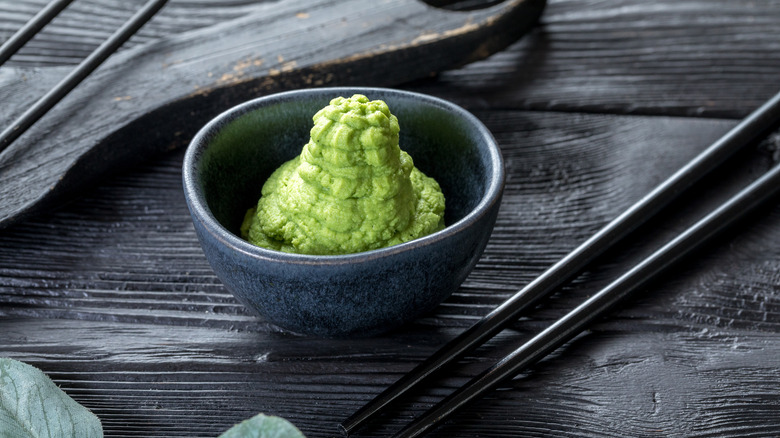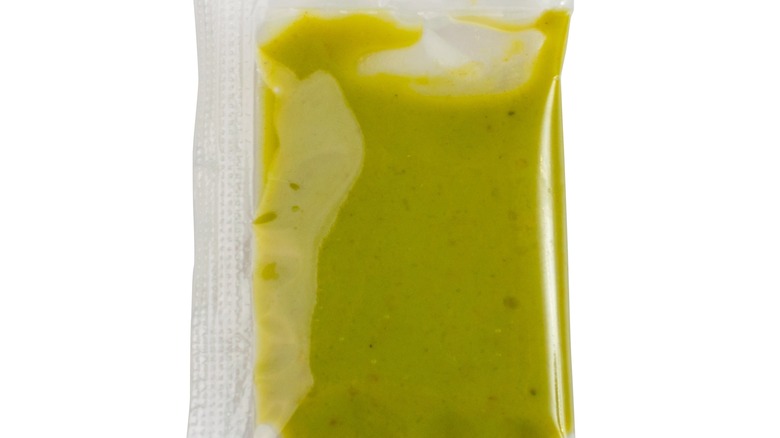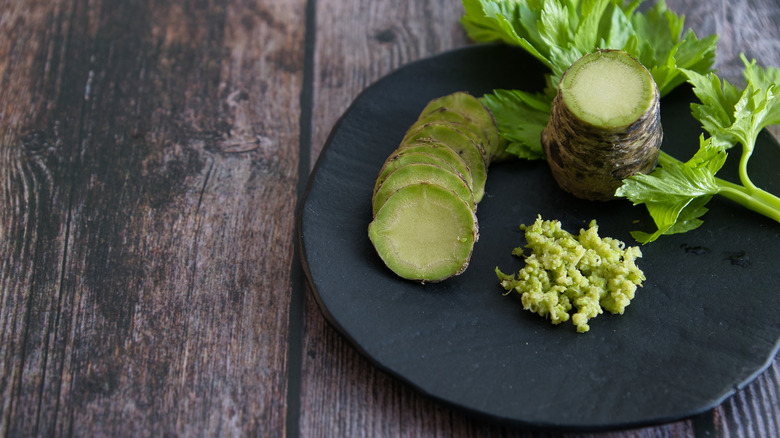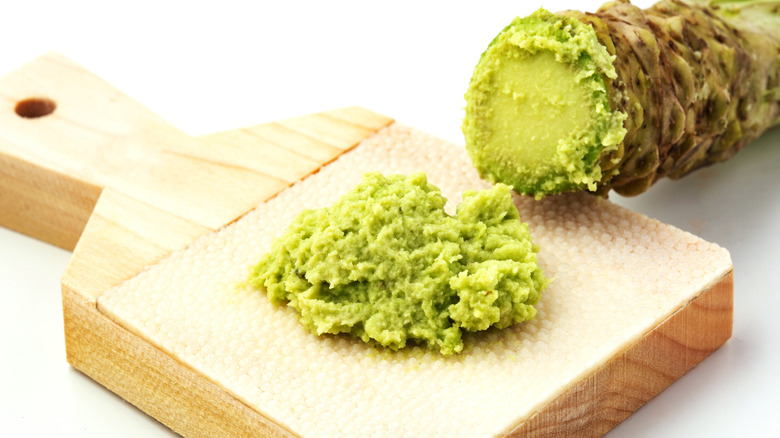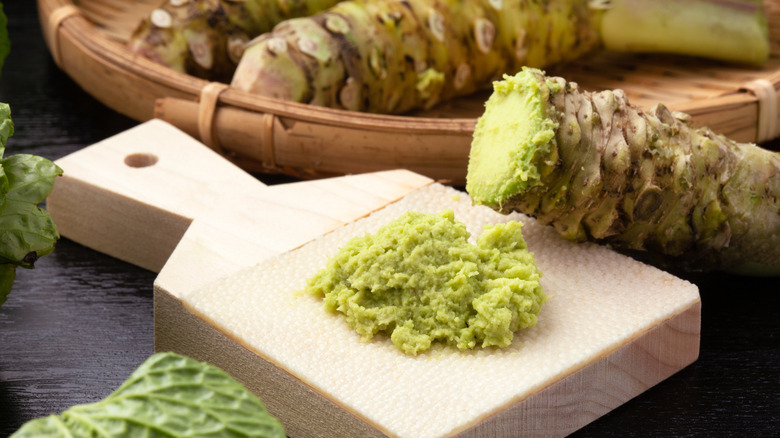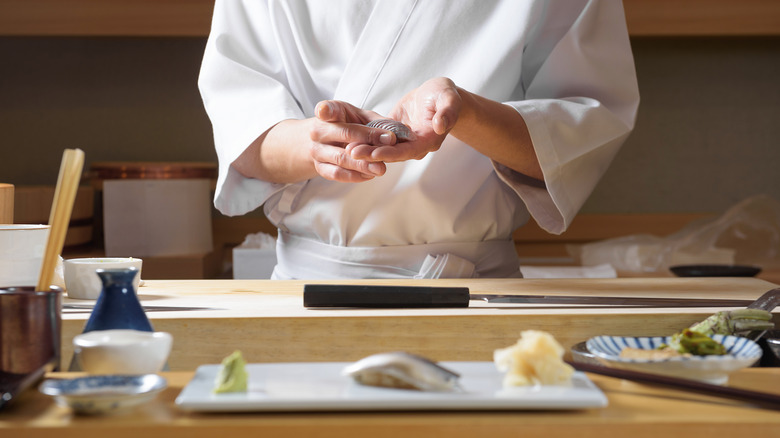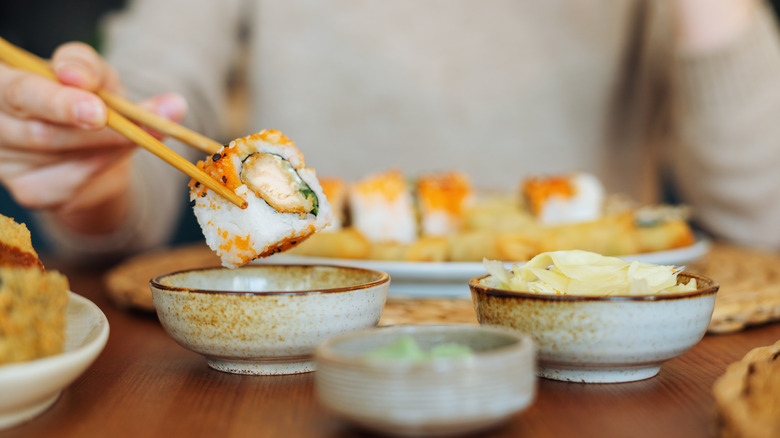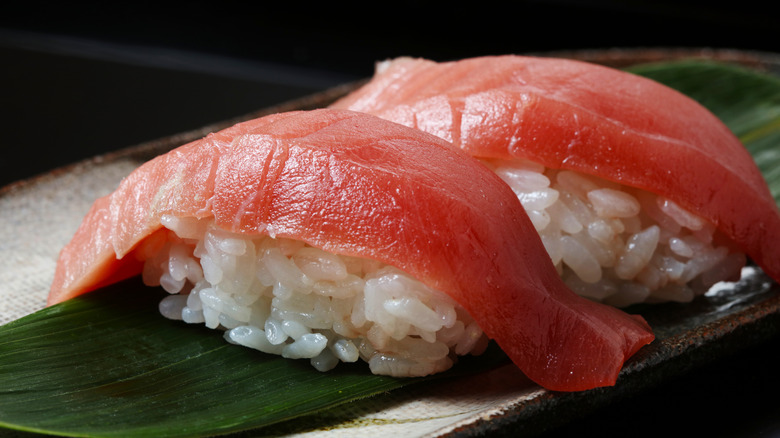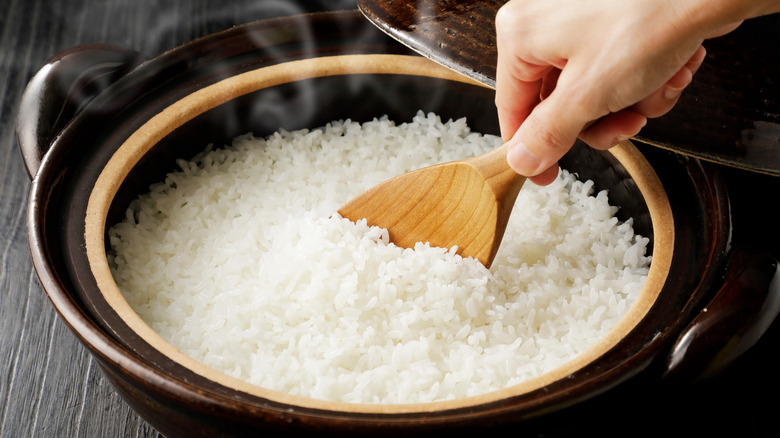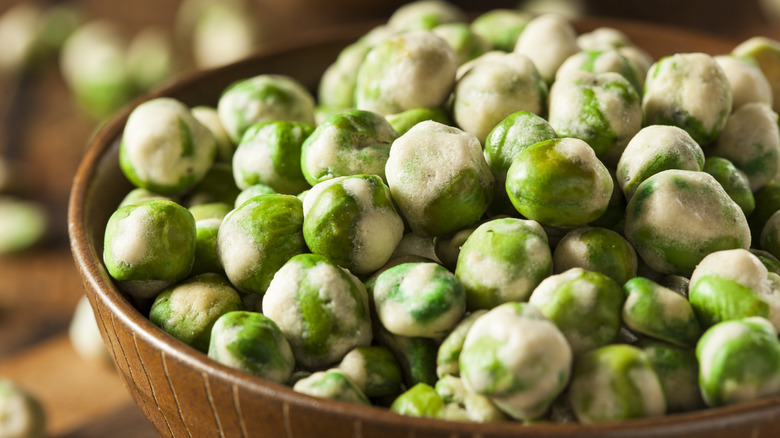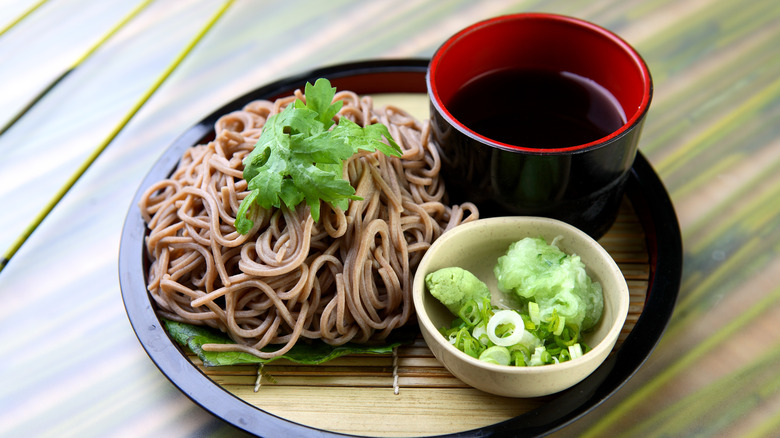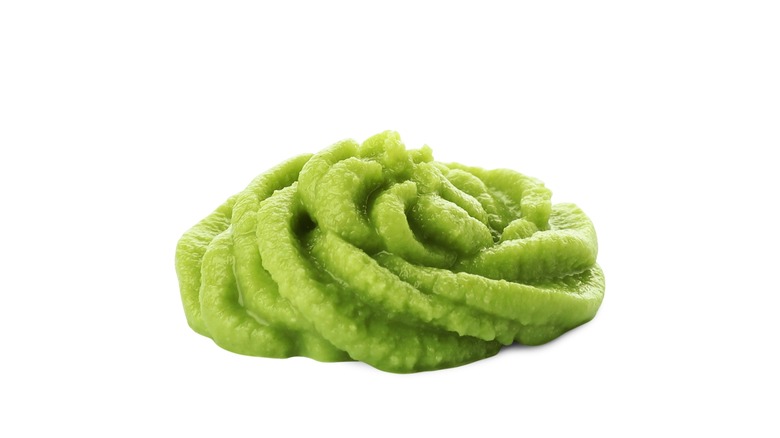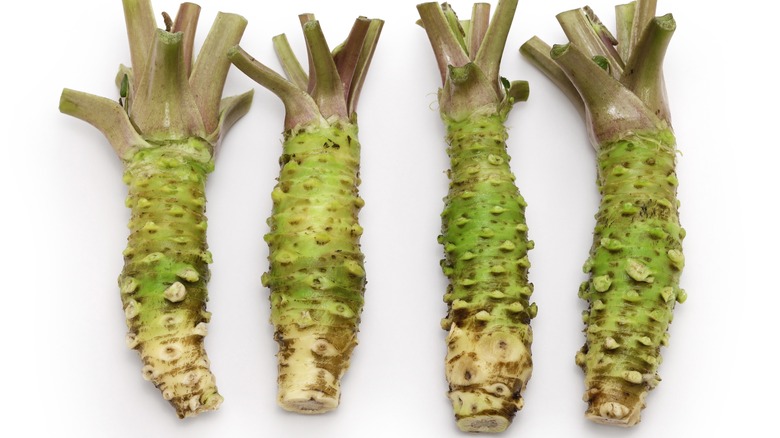Secrets Of Wasabi You'll Wish You Knew Sooner
If you're a sushi fan, you're no doubt familiar with wasabi, the bright green paste that accompanies most orders in a picturesque little blob alongside the equally pretty pink pickled ginger. But wasabi hides quite a few secrets — not the least a pungency so intense it has knocked the socks off of many a child subjected to taste tests on the internet.
Its heat is just the beginning of what wasabi offers to curious diners. Did you know, for example, that wasabi is a rhizome — similar to ginger — whose scientific name is Wasabia japonica, and that the part you eat is actually the root? How about the fact that it's been grown in Japan for more than four centuries or that etiquette dictates how (and when) you dig in at your favorite sushi bar? And of course, the most surprising characteristic of wasabi may well be its rarity. Even if you're a bona fide sushi fiend, it's unlikely that you've actually tried the real deal, which, according to Chef Edgar Valerio of Kissaki, "takes time, even years to grow." Ready to learn more? We talked to a collection of wasabi experts, and they're sharing everything you need to know about the world of wasabi.
Most wasabi you find in the U.S. is fake
Perhaps the most common misconception folks have about wasabi is that most sushi restaurants are actually serving the real deal. "I think many people believe the bright green paste frequently served at sushi restaurants is the real thing," says Kevin Biggerstaff, general manager at Hiroshi in Los Altos, CA — but this couldn't be further from the truth. The reality is that 99% of all "wasabi" sold in the U.S. is just a combo of horseradish, hot mustard, and green food coloring — with maybe some mustard oil and cornstarch thrown in. This facsimile frequently masquerades as the real deal, not just stateside, but even in Japan, where only about 5% of "wasabi" actually is what it claims to be.
True Wasabia japonica is rare in large part because of how difficult it is to produce. And it's also expensive, costing, by some estimates, $160 per kilogram to produce, a price that trickles down to the consumer. Given the short supply and cost, it's no surprise that many chefs opt for fake wasabi, which is both easier and cheaper to source.
True wasabi has a subtler flavor than fake
If you've never tried true wasabi, you're in for a real treat. Once grated, it may look similar to the hot imitation paste you know and (maybe) love, but it's miles away in terms of taste. "True wasabi has a more complex flavor profile," explains Kevin Biggerstaff. "It's surprisingly fruitier than the horseradish-based counterpart."
For those who aren't fans of loads of spice, it's a far more palatable option, according to Chef Shingo Akikuni of Shingo, who notes that despite most people believing that wasabi is "incredibly spicy," the real stuff doesn't boast the same punch of intensity, an assertion with which Biggerstaff agrees, noting that real wasabi is "less overpowering," boasting, instead, "nuanced notes of sweetness."
"True wasabi has more of a sweet, herbal flavor to it," adds Chef Max Kamakura, executive chef of Queen Omakase, "whereas 'imitation' wasabi tends to be more pungent, delivering a sharp nasal effect as soon as you take a bite."
This, according to Chef Edgar Valerio of Kissaki, stems from the way that true wasabi grows. "Real wasabi absorbs water and minerals from the soil through their roots," he says. This gives the rhizome a flavor he characterizes as "mild, creamy, and unique."
Real wasabi is available in several forms
Real wasabi is available in a number of forms, including easy-to-use powders and pastes. But as far as our experts are concerned, the root is where it's at. "If it comes as a paste, it means it was already grated, which reduces the flavor and aroma," explains Chef Shingo Akikuni. "It is like buying ground coffee instead of buying the whole bean and grinding it yourself. Same holds true for the powdered wasabi."
For the best flavor and aroma, our experts say that wasabi root should be grated as close as possible to serving — and if you want to be really traditional about it, you'll use a sharkskin paddle to do so. "Grinding a root into a paste is what will provide you with the freshest and most flavorful wasabi experience," says Kevin Biggerstaff, who recommends you seek out this specialty product at Japanese gourmet shops or online. "It's rare to come by, but if you can find a root, buy it!"
Of course, for some, the real thing might be missing some of the kick they've come to know and love. If this is the case for you, Chef Edgar Valerio of Kissaki has the perfect solution: mixing a bit of imitation wasabi powder with real wasabi root for the ideal balance between subtlety and heat.
True wasabi has a very short shelf life
Opting for fake wasabi is not just a question of price or heat. True wasabi has an incredibly short shelf life, which means that it needs to be sourced and used quickly. Chef Edgar Valerio notes that fresh wasabi only lasts about two to three weeks, and this is if it's kept in ideal conditions. "It definitely depends on the care of the chef," he notes.
For Chef Max Kamakura, this short window of perfection stems in large part from how wasabi is grown. "It is a root that thrives underwater in low temperatures," he says. "Therefore, proper preservation is essential, which requires humidity and refrigeration. To do so, consider wrapping it in damp paper, and for optimal results, store it in a vacuum-sealed package."
Kevin Biggerstaff adds that due to the fact that true wasabi loses its flavor so quickly, his team grinds it during service to retain its fresh taste for as long as possible. It's a far cry from fake wasabi, which our experts contend can be kept for a year or more — especially if it contains additives and preservatives.
High-end sushi places prefer true wasabi
It wasn't long ago that even high-end sushi spots were capitalizing on cheaper wasabi, but times have changed. A greater demand for transparency in the food industry — and the increased availability of American-grown wasabi — have led to many spots embracing the real deal, particularly on the more luxurious end of the spectrum. "All high-end omakase experiences tend to serve true wasabi to heighten the flavor of the fish being served," explains Chef Max Kamakura.
"At Hirroshi, the majority of our ingredients are imported directly from Japan," adds Kevin Biggerstaff. "We felt that in order to offer an authentic omakase experience, not unlike being in Tokyo, we must serve true wasabi."
This makes sense, according to Chef Shingo Akikuni, who argues that when serving only the best fish, true wasabi is a must. "I only use true wasabi, because the fish we serve is the best in the world," he says. "It only makes sense to put true wasabi which compliments and brings out the natural flavors of the fish."
Of course, this isn't always the case. At Kissaki, Chef Edgar Valerio splits the difference depending on which menu guests opt for. Given the high price of true wasabi, this root is only served to those who opt for the omakase or chef's choice experience. For those ordering à la carte, a combination of true and powdered wasabi is used.
It's rude to add your own wasabi to sushi
It's not uncommon to see folks at the sushi bar stirring wasabi into their soy sauce, but be warned: In some circles, this is considered a fairly egregious breach of etiquette. Adding wasabi to soy sauce changes the flavors of both, denaturing the delicate aromas. And since sushi chefs usually season each piece to perfection, adding more wasabi is somewhat akin to asking a Michelin-starred chef for ketchup.
"Typically, during an omakase experience, chefs will serve their sushi with the ideal amount of wasabi and sauce," says Chef Max Kamakura. "Sometimes additional requests may seem impolite."
That said, not all sushi chefs are quite so fussed about diners modifying their sushi according to their preferences. Kamakura notes that if wasabi is presented with your sushi, "it indicates that diners have the option to add as much as they'd like." And Chef Shingo Akikuni agrees. "In my restaurant, I put wasabi and soy sauce on every piece of nigiri so that our guests don't have to," he says, "but if a guest wants to add more, I don't have any issues with personal preference."
If you're going to add wasabi to your sushi, the best course of action is to dab a bit of wasabi on one side, then flip it and delicately dab the other side into the soy sauce.
Wasabi pairs particularly well with fatty toro
Sushi chefs use wasabi to season many different items, from rolls to nigiri and avocado-based California rolls to delicate sweet shrimp. But there are certain fish with which wasabi goes particularly well, such as fatty tuna, dubbed toro in Japanese.
Tuna has long been one of the more popular sushi options, with toro or fatty tuna rising to popularity in Japan in the first half of the 20th century. Toro comes from the belly of the tuna, which is fattier and richer than the rest of the fish. Toro is further subdivided into two types — chu-toro and o-toro — with the former being the fattiest and hailing from the upper back portion of the fish's belly. It's one of the rarest, choicest, most expensive parts of the fish, and for Chef Shingo Akikuni, this rich, silky specimen is the perfect pairing for the assertive flavor of wasabi, which can cut through the decadent fat.
True wasabi is delicious enough to enjoy (nearly) on its own
If you've got your hands on real wasabi root, the delicate flavors of the rhizome don't need much to stand out. In fact, Chef Shingo Akikuni likes to pair pure wasabi with little more than seaweed and rice.
"If you use real wasabi, you can just make a wasabi roll (seaweed + rice + wasabi) and it is delicious!" he says.
Of course, sushi fans know that not any old rice will do. Sushi chefs often say that it takes three years just to perfect sushi rice, and while this may be a slight exaggeration today, when the moisture content of rice doesn't vary quite so much as it may have in the past, preparing sushi rice properly remains a complex process of sourcing the right rice, cooking it to perfection, and seasoning it properly with sushi vinegar while fanning it to cool it to the perfect temperature. The resulting rice is the perfect base for the subtle flavors of freshly grated wasabi root.
Wasabi is a popular flavoring agent for snacks and condiments
Whether fake or real, the spicy, slightly floral flavor of wasabi has found its way into a number of store-bought snack foods, condiments, and more. Roasted or fried legumes like wasabi edamame or wasabi peas are common offerings alongside a refreshing Japanese beer. You'll also find wasabi-spiked nuts like almonds or mixes of crackers and nuts seasoned with wasabi and soy. Seeing as wasabi is such a classic condiment for sushi, it's no surprise that roasted nori sheets welcome the flavor of the rhizome as well, and given seaweed's richness in minerals, this tasty snack boasts myriad health benefits including the potential to help control blood sugar and support thyroid function (via Forbes).
But snack foods aren't the only ones that can benefit from a touch of wasabi. Sauces like mayonnaise or hot sauce take advantage of its punchy flavor and bright green color. And if you're looking for a truly special wasabi-spiked garnish, verdant wasabi tobiko are a great option. These tiny, crunchy flying fish eggs are spiked with wasabi for a pop of heat.
Wasabi doesn't have to be exclusive to sushi
Snack foods aren't the only places where wasabi can be found away from the sushi counter. Whether real or fake, wasabi can also be included in a host of different recipes. Consider taking a page from Chef Edgar Valerio's book and spiking your mayonnaise with wasabi. He also loves stirring it into mashed potatoes to give the rich side dish a welcome kick.
And Valerio isn't the only expert who likes to get creative with wasabi. Chef Max Kamakura adds it to salad dressings and cold noodle dishes, where it pairs beautifully with rich sesame oil. Other cooks like using wasabi as part of a savory marinade for salmon alongside ginger, soy sauce, and sesame oil, and it's also a tasty addition to a marinade for grilled chicken. Wasabi can even stand in for horseradish in a zippy Bloody Mary.
Fake wasabi may be the better option for cooking
While there's no comparing fake and real wasabi when it comes to sushi, this isn't necessarily the case when you're cooking, at least according to Chef Max Kamakura. "If you are preparing a sauce for salads or similar dishes," he says, "the powdered form of wasabi might even surpass fresh wasabi in enhancing flavor."
Much as the nuanced flavors of top-notch Burgundy would be lost in sangria, the subtle floral aromas of true wasabi may be masked if combined with other ingredients. Fake wasabi, meanwhile, packs enough of an assertive punch to stand out — and at a much lower price point. The less expensive option also gives you free rein to experiment. Consider swapping wasabi paste for horseradish or mustard in your favorite recipes, such as cocktail sauce or meat marinades. Beef goes wonderfully with horseradish cream, but using wasabi instead can add a surprising and welcome pop of color. Wasabi paste can even stand in for mustard in rich homemade mac and cheese.
True wasabi has loads of health benefits
While both fake and true wasabi have their merits, if health benefits are your chief motivation for picking one or the other, it's best to choose the real thing. Wasabi boasts a host of health benefits, including antibacterial properties that may help treat peptic ulcers caused by the bacterium H. pylori and could even ward against food poisoning, per Healthline.
Wasabi has also been shown to have potential anti-inflammatory properties, which are majorly beneficial in a world where so many of us suffer from chronic inflammation due to poor diet and stress (via Cleveland Clinic). Several mouse studies have also indicated that wasabi may help promote weight loss, and some studies have even shown that wasabi could have anti-cancer properties, according to Healthline. Some evidence also shows that wasabi may be beneficial in promoting bone health, brain health, and more. All the more reason to grate up some fresh wasabi and dig in.
